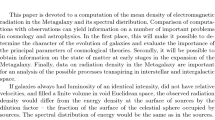Sommario
Si discutono i metodi sino ad ora seguiti per distinguere le due principali componenti dei raggi cosmici (mesoni ed elettroni) presenti a bassa quota. Si riferisce di nuove misure nelle quali si è cercato di mettere a confronto i due criteri fondamentali utilizzati per questa distinzione, i quali si sono dimostrati per certi riguardi complementari. Si esaminano le cause di errore nel dispositivo qui impiegato e nei dispositivi consimili e si indica il modo di eliminarli: si discutono in particolare gli errori dovuti agli elettroni di bassa energia che non si moltiplicano in cascata attraversando un opportuno sciamatore e per i quali la perdita percentuale di energia per ionizzazione non è trascurabile. Il criterio di distinguere gli elettroni per la loro proprietà di produrre sciami, in cascata è incerto anche in misure di confronto a quote diverse con uno stesso dispositivo, perchè implica la conoscenza dello spettro energetico degli elettroni incidenti sul telescopio. Dalle nostre misure si è ricavata, sino a un momento di 3·108 eV/c, la curva di assorbimento dei mesoni a Milano (120 m sul livello del mare) e a 2100 m. Si discutono le possibili cause di errore in alcune precedenti misure del numero dei mesoni lenti. Dall'esame dei nostri risultati e di quelli di altri autori si ricava come aumenta con l'altezza la frequenza dei mesoni lenti. Il confronto tra queste misure e quelle diRossi e collaboratori induce a stimare che una parte delle particelle penetranti osservate normalmente come mesoni in dispositivi del tipo da noi impiegato siano di altra natura che i mesoni ordinari, in modo particolarmente sensibile dalla quota di 3500 m in su. Il confronto della frequenza degli elettroni a Milano e a 2100 m dà risultati che si inquadrano nella recente discussione diBernardini, Cacciapuoti eQuerzoli.
Summary
The author discusses the methods till now followed in order to distinguish the two principal components of cosmic rays (mesons and electrons) present at low levels. He reports new measurements in which he has tried to compare the two foundamental criteria utilized for this distinction, the one consisting in the distinction of the electrons by their property of cascade multiplication, the other in comparing the different dependence of the absorption from the atomic number of the absorber. The first method has been found the most suitable for the reckoning of the relative number of the slow mesons at sea level.
Our device (fig. 1) consisted in a disposition of counters through which we obtained adsorption curves of the cosmic radiation in different elements, and in same time we could distinguish the electrons through the property of producing showers in a suitable layerS 1.
The causes of errors in the employd device and in similar ones are examined and the manner of their elimination shown: particularly are discussed the errors due to electrons of low energy, which are not subject to cascade multiplication passing through a shower producer and for which the percental loss of energy due to ionisation is not negligible.
The distinction of electrons through their property of cascade showers production is particularly uncertain, also in measurements at different levels with the same device because it implies the knowledge of the energy spectrum of the electrons falling on the telescope.
From our measurements we have deduced, up to a moment of 3·108 eV/c, the absorption curve of the mesons at Milan (120 m on sea level) and at 2100 m. The possible causes of error in some precedent measurements of the number of slow mesons are discussed. From the perusal of our results and of those of other authors we deduced how the frequency of slow mesons increases with height. The comparison of these measurements with those ofRossi and co-workers induces to reckon that a part of the penetrating particles normally observed as mesons should differ from the ordinary mesons, and this is particularly evident from 3500 m up.
The comparison of the frequence of electrons at Milan and at 2.100 m gives results which agree with the recent discussion ofBernardini, Cacciapuoti andQuerzoli.
Similar content being viewed by others
References
G. Bernardini eB. N. Cacciapuoti:Ric. Scient.,10, 981 (1941).
Aiya eSaxena:Phys. Rev.,66, 183 (1944);D. B. Hall:Phys. Rev.,66, 321, (1944);Vikram Sarabhai:Phys. Rev.,65, 250 (1944).
P. Auger:Phys. Rev.,61, 684 (1942);K. Greisen:Phys. Rev.,63, 323 (1943).
B. Rossi, M. Sands eR. F. Sard:Phys. Rev.,72, 120 (1947).
D. Froman eJ. C. Stearns:Rev. of Mod. Phys.,10, 133 (1938).
W. T. Scott eG. E. Uhlenbeck:Phys. Rev.,62, 497 (1942).
S. Nassar eW. E. Hazen:Phys. Rev.,69, 298 (1946).
N. Arley:Proc. Royal Soc.,168, 519 (1938).
K. Greisen: loco citato.
W. E. Hazen eB. Lombardo jr.:Phys. Rev.,68, 74 (1945).
G. Bernardini, B. N. Cacciapuoti eB. Querzoli:Nuovo Cimento,3, 349 (1946).
G. Salvini:Nuovo Cimento,3, n. 4 (1946).
J. G. Wilson:Nature,158, 414 (1946).
H. Paul Koenig:Phys. Rev.,69, 590 (1946).
B. Rossi eK. Greisen:Rev. of Mod. Phys.,13, 240 (1941).
M. Schein, E. O. Wollan eG. Groetzinger:Phys. Rev.,58, 1027 (1940).
W. M. Powell:Phys. Rev.,69, 385 (1946).
Author information
Authors and Affiliations
Rights and permissions
About this article
Cite this article
Salvini, G. La distinzione delle componenti della radiazione cosmica nella bassa atmosfera e la frequenza relativa dei mesoni lenti. Nuovo Cim 5, 213–234 (1948). https://doi.org/10.1007/BF02784457
Received:
Published:
Issue Date:
DOI: https://doi.org/10.1007/BF02784457




